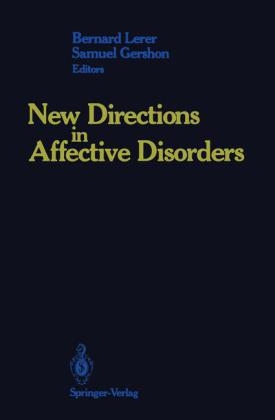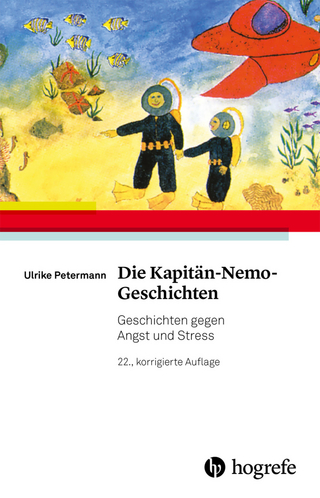
New Directions in Affective Disorders
Springer-Verlag New York Inc.
978-0-387-96769-1 (ISBN)
- Titel ist leider vergriffen;
keine Neuauflage - Artikel merken
National Institute ofMental Health Statistics estimate that 15% of adults between 18 and 74 years ofage may be suffering from serious depressive disorders in any given year. Depression is a serious condition with a high mortality. A suicide rate ofapproximately 20,000 deaths per year as a result of this illness is almost certainly a conservative estimate.
Contributors.- I Pathogenesis of Affective Disorders and Basic Mechanisms of Drug Action.- I.A. Animal Models and Antidepressant Predictability.- 1 Neurochemical and Behavioral Effects of Stress: A Rat Model of Depression.- 2 Study of Olfactory Bulbectomized Rats: Revelations About Major Depressive Disorder.- 3 Bilaterally Olfactory Bulbectomized Rat Model of Depression.- 4 Behavioral Despair: Past and Future.- 5 Genetically Nervous and Normal Pointer Dogs: Relation Between Hearing and Behavioral Abnormalities.- 6 Agonist-Induced Down-Regulation of ?1-Adrenergic Receptors: Possible Biochemical Rationale for Novel Antidepressants.- 7 Behavioral Pharmacology and Clinical Antidepressant Effects of ?-Adrenergic Agonists.- I.B. Monoamines and Neuropeptides.- 8 Beyond Nosology in Biological Psychiatry: Prolegomena of a Functional Psychopathology.- 9 Serotonergic Aspects of Agonistic Behavior.- 10 Noradrenergic and Serotonergic Dysfunction in the Affective Disorders.- 11 Neuropeptides and Affective Disorders.- 12 Antemortem and Postmortem Measures of Central Nervous System Serotonergic Function: Methodological Issues.- 13 Postmortem Investigation of Serotonergic and Peptidergic Hypotheses of Affective Illness.- I.C. Cholinergic Mechanisms.- 14 Genetic Animal Model of Depression with Cholinergic Supersensitivity.- 15 Impact of the Cholinergic System on the Hypothalamic-Pituitary- Adrenocortical Axis and on REM Sleep.- 16 Relation Between m-Cholinoceptor Density on Human Blood Cells and Psychological Predisposition Factors for Depression.- 17 Differential Effects of Physostigmine in Alcoholics, Alcoholics with Affective Disorder, and Normal Individuals.- I.D. Basic Mechanisms of Antidepressants and Anxiolytics.- 18 Serotonin/Norepinephrine/Steroid Receptor Link in Brain and the Mode of Action of Antidepressants: Update and New Perspectives.- 19 Presynaptic Sites of Antidepressant Action: Monoamine Transport Systems and Release-Modulating Autoreceptors.- 20 Light-Dark-Related Changes in the Serotonin Uptake Molecular Complex in Rat Brain: Involvement in Antidepressant Action.- 21 Role of Serotonin (and Coexisting Peptides) in the Action Mechanism of Antidepressant Drugs.- 22 GABAB Receptors and Antidepressant Drugs.- 23 Antidepressants and Phospholipid Metabolism: ?-Adrenoceptor Regulation in Cultured Human Cells.- 24 Nicotinic Effects of Antidepressants.- 25 Molecular Sites of Anxiolytic Action.- 26 Modulation of the Benzodiazepine/GABA Receptor Chloride Ionophore Complex: Evidence for an Asymmetrical Response of GABA-Gated Chloride Channels to Stress.- I.E. Basic Mechanisms of Lithium Action.- 27 Lithium Inhibition of Adenylate Cyclase Activity: Site of Action and Interaction with Divalent Cations.- 28 Comparison of the Effects of Lithium and Antidepressant Drugs on Second Messenger Systems in Rat Brain.- 29 Effects of Lithium Ions on the Metabolism of Phosphoinositides.- 30 Comparison of Theories of Lithium Action Based on Phosphatidylinositol Metabolism with Theories Based on Cyclic AMP.- 31 Serotonin and Catecholamines in Lithium Treatment.- 32 Lithium and Calcium Antagonists: Do They Act on One Neuronal Function?.- 33 Red Blood Cell Lithium Transport in Affective Illness: A Possible Mechanism of Action of Lithium.- I.F. Monoamine Oxidase Inhibitors.- 34 Selective Localization and Selective Inhibition of Monoamine Oxidase in Human Brain.- 35 Effect of Selective Monoamine Oxidase Substrates and Inhibitors on Lipid Peroxidation and Their Possible Involvement in Affective Disorders.- 36 Pharmacology of Monoamine Oxidase Inhibitors.- 37 Regulation of Functional Cytoplasmic Pool of Serotonin by MAO-A and MAO-B: Implications for Antidepressant Therapy.- 38 Neurochemical Profile of the Antidepressant Moclobemide, a Reversible Type A Monoamine Oxidase Inhibitor with Minimal Tyramine Potentiating Activity in Rats.- II Neurobiology of Affective Disorders.- II. A. New Genetic Findings.- 39 Power of Genetic Linkage Studies for Heterogeneous Disorders.- 40 Single Locus Markers in Affective Disorders.- 41 One Form of Bipolar Affective Disorder is Mapped to Chromosome 11.- 42 X-Linkage Studies in Affective Disorders.- 43 Recombinant DNA Studies of X Linkage in Affective Disorders.- 44 Segregation Analysis in Families of Affective Patients Subdivided According to Treatment Outcome and Personality Disorders.- II.B. Biological Markers.- 45 Peripheral Blood Cell Biological Markers in Depression.- 46 ?2-Adrenoceptors and Associated Functional Responses in Endogenous Depression.- 47 Neurotransmitters and Their Metabolites in CSF in Depression and Under the Influence of Antidepressant Drugs.- 48 High Affinity Imipramine Binding and Serotonin Uptake in Human Platelets as a Peripheral Biological Marker in Neuropsychiatric Disorders.- 49 Resting EEG as a Genetic Marker.- 50 EEG Sleep Changes in Recurrent Depression.- II.C. Chronobiology.- 51 Circadian and Ultradian Rhythms of 3-Methoxy-4-Hydroxyphenylglycol in Subtypes of Depressive Illness.- 52 Chronobiological Dysregulation of the Noradrenergic System in Depression.- 53 Diurnal Rhythm of Cortisol in Depression: What Is Normal and What Is Not.- 54 Circadian Rhythm Disturbance in Affective Disorders: Facts and Fictions.- II.D. Psychoneuroendocrinology.- 55 Pathophysiology of the Limbic-Hypothalamic-Pituitary-Adrenocortex System: An Overview.- 56 Neuroendocrine Dysfunctions in Affective Disorders: Effects of Clinical Changes.- 57 Preclinical and Clinical Investigations of Corticotropin-Releasing Factor: Assessment of Its Role in Depressive Disorders.- 58 Neuroendocrine Effects of Intravenous Ovine Corticotropin-Releasing Factor and Human Growth Hormone-Releasing Factor in Affective Disorder Patients and Normal Controls.- 59 TRH Stimulation Test in Psychiatry.- 60 Luteinizing Hormone and Prolactin Response to Buprenorphine in Depression and Schizophrenia.- 61 Neuroendocrine Factors in Antidepressant Drug Therapy.- 62 Neuroendocrine Studies of the Mechanism of Action of Antidepressant Drugs.- 63 Growth Hormone Response to Clonidine Stimulation in Affective Disorders: Effects of Lithium Therapy.- 64 Endocrinological Diseases Mimicking Affective Disorders.- III Affective Disorders in Populations at Risk.- III.A. Affective Disorders and Suicide.- 65 Epidemiology and Psychosocial Risk Factors for Suicide.- 66 Genetics and Suicidal Behavior in the Affective Disorders.- 67 Suicidal Behavior Among Children and Adolescents.- 68 Death Anxiety in a Psychiatric Population of Suicidal and Nonsuicidal Adolescents.- 69 Neurotransmitters and Neurotransmitter Receptors in Depressed Suicide Victims.- 70 Peripheral Serotonin and Catecholamine Levels and Suicidal Behavior.- 71 Past Suicide Attempt and Monoamine Metabolites: Comparing CSF Concentrations and Angularized Ratios.- III.B. Affective Disorders During Childhood and Adolescence.- 72 Affective Disorders During Childhood and Adolescence: Introduction.- 73 Study and Treatment of Childhood Depression as a Prototype for the Research and Conceptualization of Other Psychopathologies in Child Psychiatry.- 74 New Hypotheses of the Pharmacotherapy of Childhood and Adolescent Depression.- 75 Depression in Children: Defining the Therapeutic Range for Imipramine.- 76 Good Results with the Dexamethasone Suppression Test in Adolescent Inpatients: Implications for Diagnosis in Adolescent Psychiatry.- 77 Social Development of Children at High Risk for Depression: Preadolescence and Early Adolescence.- 78 Psychiatric Disorders in Children of Depressed Parents.- III.C. Affective Disorders in the Elderly.- 79 Diagnostic Criteria for Depression in Alzheimer's Disease.- 80 Association of Somatic Disease with Affective Disorders in Middle and Old Age.- 81 Excess Mortality in Late Life Depression.- 82 Adverse Effects of Antidepressant Drugs in the Elderly.- III.D. Affective Disorders and Reproductive Cyclicity in Women.- 83 Menarche and Menstrual Symptoms: Psychosocial Perspectives.- 84 Affect and Nurturance in First-Time Mothers: Role of Psychobiological Influences.- 85 Myth of Menopausal Depression.- IV Related Affective Syndromes.- IV.A. Anxiety Disorders.- 86 Epinephrine-Induced Anxiety and Regional Cerebral Blood Flow in Anxious Patients.- 87 Neurobiological Mechanisms of Panic Anxiety: Review of the Behavioral, Biochemical, and Cardiovascular Effects of Three Panicogenic Stimuli.- 88 Caffeine Model of Panic.- 89 Pharmacological Treatment of Panic Disorders.- IV.B. Obsessive Compulsive Disorder.- 90 Heterogeneity and Coexistence in DSM-III-R Obsessive Compulsive Disorder.- 91 Applicability of Models of Anxiety to Obsessive Compulsive Disorder.- 92 Frontal Lobe Involvement in Obsessive Compulsive Disorder: Electroencephalographic Evidence.- 93 Pharmacological Treatment of Obsessive Compulsive Disorder.- 94 Use of Antiandrogens in the Treatment of Obsessive Compulsive Disorders: Theoretical Considerations.- IV.C. Posttraumatic Stress Disorder.- 95 Psychobiology of the Trauma Response.- 96 Psychophysiology of Posttraumatic Stress Disorder.- 97 From CSR to PTSD.- 98 Social Support Versus Self-Sufficiency in Traumatic and Posttraumatic Stress Reactions.- 99 Pharmacotherapy Trials in Posttraumatic Stress Disorder: Prospects and Problems.- 100 Psychobiology of Dissociation.- IV.D. Anorexia and Bulimia.- 101 Eating Disorder and Affective Disorder: How Real Is the Relation?.- 102 Neuroendocrine Findings in Depression, Anorexia Nervosa, and Bulimia.- 103 Antidepressant Therapies for Treatment of Anorexia Nervosa and Bulimia Nervosa.- 104 Psychodynamic Reflections on Anorexia Nervosa.- IV.E. Schizoaffective Disorder.- 105 Schizoaffective Psychoses: Six Hypotheses.- 106 Psychopharmacology of Schizoaffective Mania.- 107 Neuroendocrinology of Schizoaffective Disorders.- 108 Prophylaxis of Schizoaffective Disorders.- 109 Treatment of Depression in Schizophrenia.- V New Directions in Treatment.- V.A. Classification and Pharmacotherapy.- 110 Pharmacotherapy and the Overlap Between Affective and Other Psychiatric Disorders.- 111 Classification of Affective Disorders and Psychopharmacology: Rosetta Stone or Hypothetical Construct?.- 112 Diagnostic Dimensions of the Newcastle Scales and the Response to Antidepressant Treatments.- V.B. Anticonvulsants in Affective Disorder.- 113 Mode of Action of Anticonvulsants in Affective Illness.- 114 Acute and Prophylactic Properties of Carbamazepine in Bipolar Affective Disorders.- 115 Use of Carbamazepine in Affective Illness.- 116 Action of Carbamazepine Suspension in Acute Manic Syndromes.- 117 Carbamazepine in the Long-Term Treatment of Affective Disorders: Research Strategies.- 118 Plasma Levels of Carbamazepine in Affective Disorder.- 119 Efficacy and Safety of Lithium-Carbamazepine Combination in Mania.- V.C. Treatment Strategies for Resistant Depression.- 120 Patient Characteristics and Factors Associated with Chronic Depression and Its Treatment.- 121 Resistant Depression: Clinical Characteristics and Response to Treatment.- 122 Clinical Indicators in Resistant Depressions.- 123 Combined MAO Inhibitor and Tri/TetraCyclic Antidepressant Treatment in Therapy-Resistant Depression.- 124 Management of Resistant Major Depression.- V.D. Antidepressants in Clinical Practice: Placebo Response in Depression.- 125 Clinical Characteristics of Placebo Response in Depression.- 126 Pretreatment Pituitary-Adrenocortical Status: Prediction of Placebo Response in Depression.- 127 Clinical Features, DST, and Response to Placebo in Depressed Outpatients.- V.D. Antidepressants in Clinical Practice: Plasma Levels of Antidepressants.- 128 Antidepressant Drug Measurement: Review of Methods for Clinical Application.- 129 Relation Between Plasma Antidepressant Concentrations and Clinical Effects.- 130 Clinical Implications of the Tricyclic Antidepressant Hydroxy-Metabolites.- 131 Disposition and Effects of E-10-Hydroxynortriptyline-An Active Metabolite of Nortriptyline.- 132 Genetic Polymorphism in Drug Oxidation: Implications for the Clinical Use of Tricyclic Antidepressants.- V.D. Antidepressants in Clinical Practice: Adverse Effects of Antidepressants.- 133 Overdosage of Antidepressants.- 134 Risk-Benefit Assessment of Deaths from Adverse Drug Reactions and Overdosage with Antidepressants.- 135 Assessing the Safety of Antidepressant Drugs After Marketing: A U.S. View.- 136 Tricyclic Antidepressants, Electroconvulsive Therapy, and Memory in Depressed Patients.- V.E. GABA-Mimetics as Antidpressants.- 137 GABA Theory of Depression and Antidepressant Drug Action.- 138 GABA-Mimetic Agent Fengabine in the Treatment of Depression: An Overview.- 139 Antidepressant Activity of Progabide and Fengabine.- 140 Activity of Fengabine, a GABAergic Drug, in Depression.- 141 Depression in Children and Adolescents: A Controlled Study of Progabide Versus Imipramine.- V.F. Therapeutic Variations in ECT Administration.- 142 Electrode Placement and Stimulus Waveform: Conceptual and Practical Issues.- 143 Unilateral and Bilateral Electroconvulsive Therapy in Depressive Illness.- 144 ECT: Rising Trends and Current Policy.- 145 Pharmacological Manipulation of Seizure Duration: A New Direction in ECT Technology.- 146 "Isoflurane Narcotherapy" in Depression: Methodological Issues.- V.G. Psychotherapy of Depression.- 147 Response to Combined Pharmacotherapy and Psychotherapy Among Recurrent Depressives.- 148 Cognitive Therapy for Major Depressive Disorder: Current Status.- 149 Use of Reminiscing in the Psychotherapy of Depression.
| Zusatzinfo | 14 black & white illustrations, biography |
|---|---|
| Verlagsort | New York, NY |
| Sprache | englisch |
| Gewicht | 1235 g |
| Themenwelt | Sachbuch/Ratgeber ► Gesundheit / Leben / Psychologie ► Krankheiten / Heilverfahren |
| Sachbuch/Ratgeber ► Gesundheit / Leben / Psychologie ► Psychologie | |
| Geisteswissenschaften ► Psychologie ► Allgemeines / Lexika | |
| Medizin / Pharmazie ► Medizinische Fachgebiete ► Neurologie | |
| Medizin / Pharmazie ► Medizinische Fachgebiete ► Pharmakologie / Pharmakotherapie | |
| Medizin / Pharmazie ► Medizinische Fachgebiete ► Psychiatrie / Psychotherapie | |
| Naturwissenschaften ► Biologie ► Humanbiologie | |
| Naturwissenschaften ► Biologie ► Zoologie | |
| ISBN-10 | 0-387-96769-9 / 0387967699 |
| ISBN-13 | 978-0-387-96769-1 / 9780387967691 |
| Zustand | Neuware |
| Haben Sie eine Frage zum Produkt? |
aus dem Bereich


